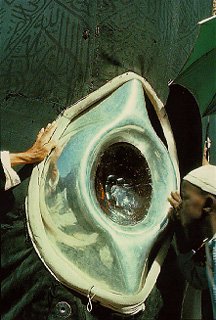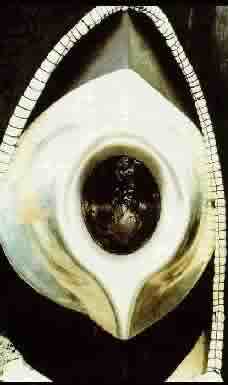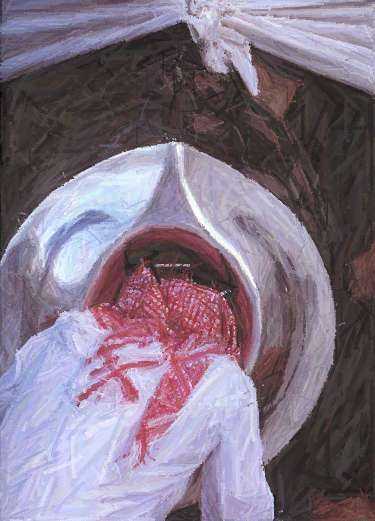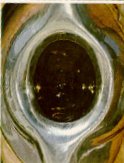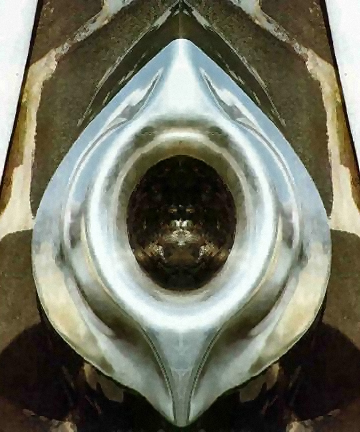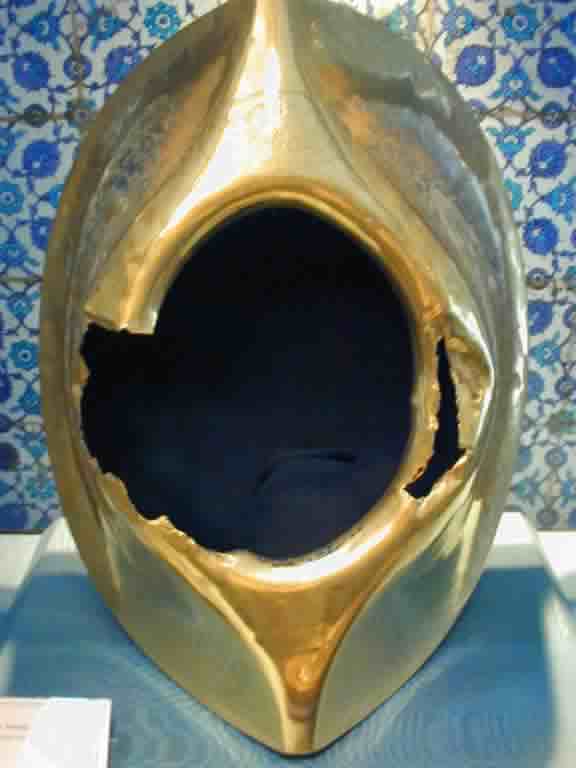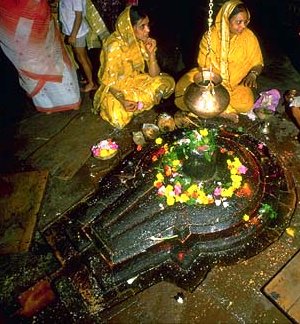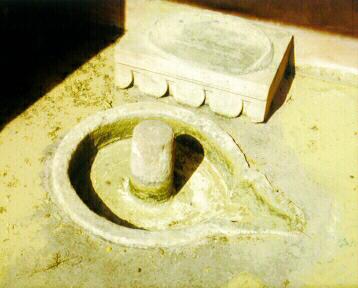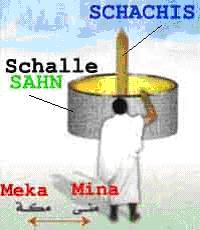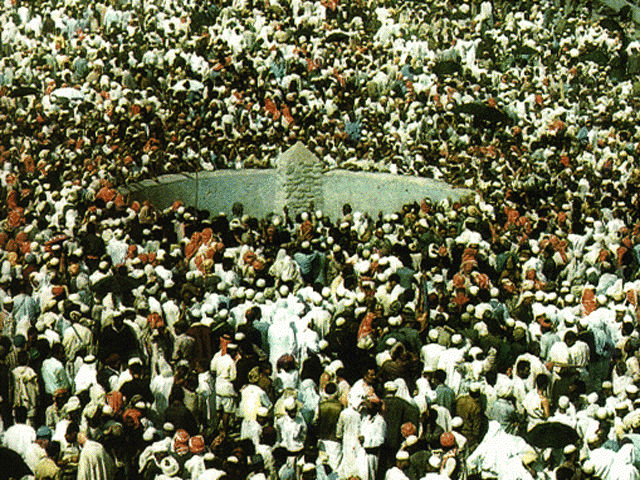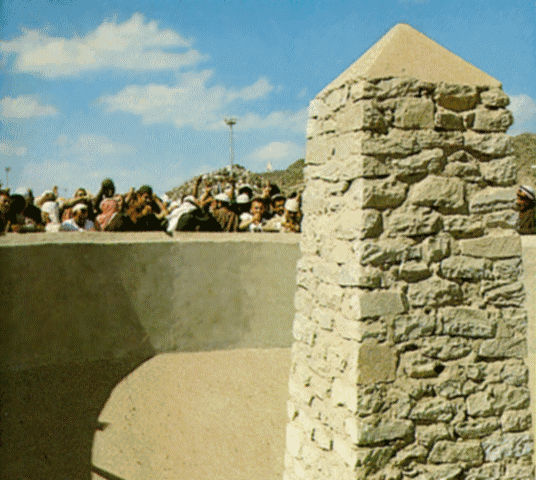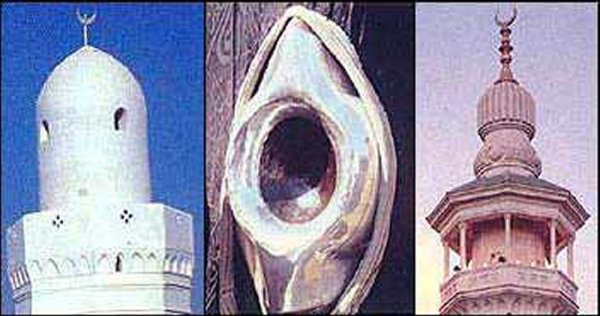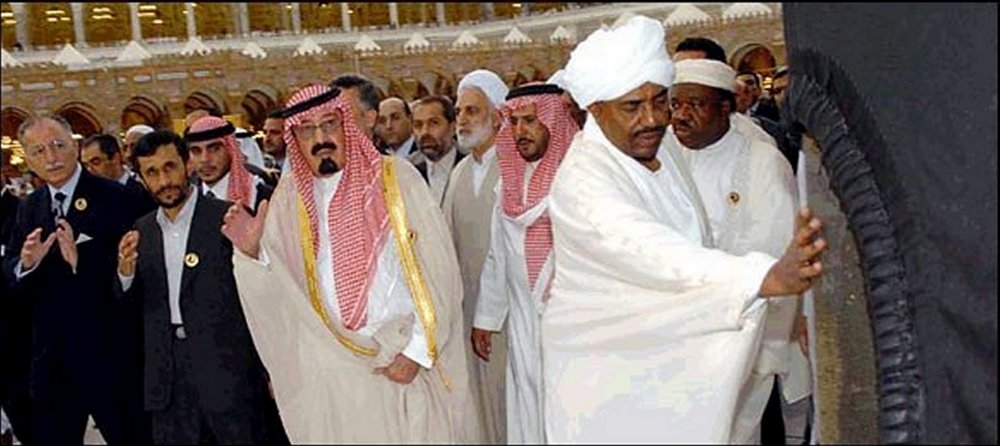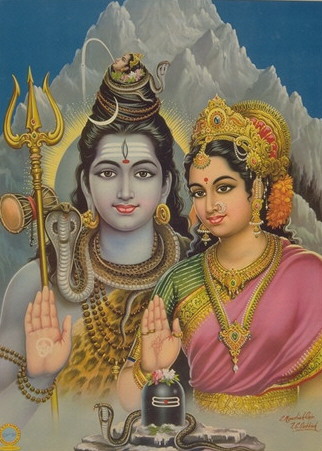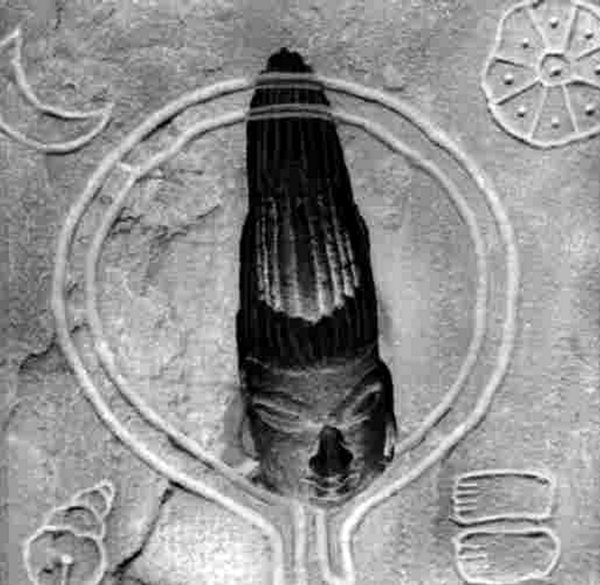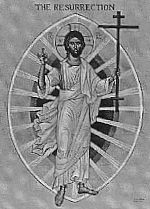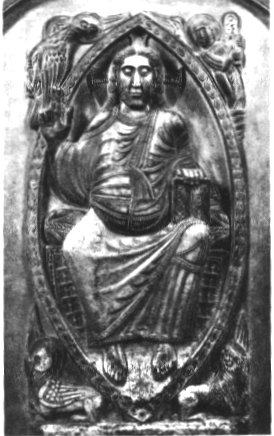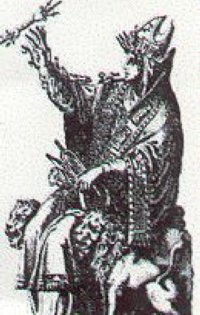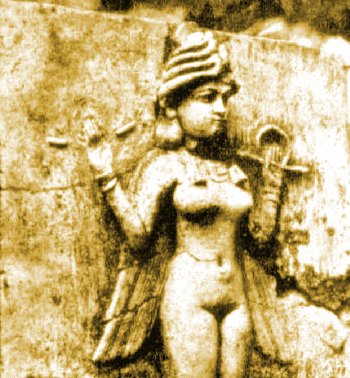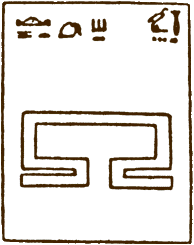These posts are from http://indiaculture.net/talk/messages/128/9481.html?1189199619
By ahmed on Wednesday, April 18, 2007 - 06:34 am: in i m a muslim and agree to what all you have written we all muslims are hindus actually but nobody is realising this fact that we all worship lord great shiva WE were fooled and betreeyed by prophit who just cheated us. i have worked all my life in a mosque not now i realise what blunder i had done. there donsnt exist anything as muslim and the worst thing was when i tried to look into othe mirror with my hands holding om it showed 786 we muslims have been betrayed fooled cheated and were forced to convert into muslims by that idoitic prophit i m sorry to say this but thats the fact
By Proud Pagan on Saturday, October 28, 2006 - 05:09 am:
Was the Kaaba Originally a Hindu Temple? By P.N. Oak Arabic tradition has lost trace of the founding of the Kaaba temple. The discovery of the Vikramaditya inscription affords a clue. King Vikramaditya is known for his great devotion to Lord Mahadev (Siva). At Ujjain (India), the capital of Vikramaditya, exists the famous shrine of Mahankal, i.e., of Lord Shankara (Siva) associated with Vikramaditya. Since according to the Vikramaditya inscription he spread the Vedic religion, who else but he could have founded the Kaaba temple in Mecca? A few miles away from Mecca is a big signboard which bars the entry of any non-Muslim into the area. This is a reminder of the days when the Kaaba was stormed and captured solely for the newly established faith of Islam. The object in barring entry of non-Muslims was obviously to prevent its recapture. As the pilgrim proceeds towards Mecca he is asked to shave his head and beard and to don special sacred attire that consists of two seamless sheets of white cloth. One is to be worn round the waist and the other over the shoulders. Both these rites are remnants of the old Vedic practice of entering Hindu temples clean- and with holy seamless white sheets. The main shrine in Mecca, which houses the Siva emblem, is known as the Kaaba. It is clothed in a black shroud. That custom also originates from the days when it was thought necessary to discourage its recapture by camouflaging it. According to the Encyclopaedia Britannica, the Kaaba has 360 images. Traditional accounts mention that one of the deities among the 360 destroyed when the place was stormed, was that of Saturn; another was of the Moon and yet another was one called Allah. That shows that in the Kaaba the Arabs worshipped the nine planets in pre-Islamic days. In India the practice of ‘Navagraha’ puja, that is worship of the nine planets, is still in vogue. Two of these nine are Saturn and Moon. In India the crescent moon is always painted across the forehead of the Siva symbol. Since that symbol was associated with the Siva emblem in Kaaba it came to be grafted on the flag of Islam!!! And on Turkey's and Pakistan's and Malaysia's and Uzbekistan's closely resembles. Another Hindu tradition associated with the Kaaba is that of the sacred stream Ganga (sacred waters of the Ganges river). According to the Hindu tradition Ganga is also inseparable from the Shiva emblem as the crescent moon. Wherever there is a Siva emblem, Ganga must co-exist. True to that association a sacred fount exists near the Kaaba. Its water is held sacred because it has been traditionally regarded as Ganga since pre-Islamic times (Zam-Zam water). [Note: Even today, Muslim pilgrims who go to the Kaaba for Haj regard this Zam-Zam water with reverence and take some bottled water with them as sacred water.] Muslim pilgrims visiting the Kaaba temple go around it seven times. In no other mosque does the circumambulation prevail. Hindus invariably circumambulate around their deities. This is yet another proof that the Kaaba shrine is a pre-Islamic Indian Shiva temple where the Hindu practice of circumambulation is still meticulously observed. The practice of taking seven steps- known as Saptapadi in Sanskrit- is associated with Hindu marriage ceremony and fire worship. The culminating rite in a Hindu marriage enjoins upon the bride and groom to go round the sacred fire four times (but misunderstood by many as seven times). Since "Makha" means fire, the seven circumambulations also prove that Mecca was the seat of Indian fire-worship in the West Asia. It might come as a stunning revelation to many that the word ‘ALLAH’ itself is Sanskrit. In Sanskrit language Allah, Akka and Amba are synonyms. They signify a goddess or mother!!! The way they treat their women! The term ‘ALLAH’ forms part of Sanskrit chants invoking goddess Durga, also known as Bhavani, Chandi and Mahishasurmardini. The Islamic word for God is., therefore, not an innovation but the ancient Sanskrit appellation retained and continued by Islam. Allah means mother or goddess and mother goddess. The Hindus have a pantheon of 33 gods. People in Asia Minor too worshipped 33 gods before the spread of Islam. The lunar calendar was introduced in West Asia during the Indian rule. The Muslim month ‘Safar’ signifying the ‘extra’ month (Adhik Maas) in the Hindu calendar. The Muslim month Rabi is the corrupt form of Ravi meaning the sun because Sanskrit ‘V’ changes into Prakrit ‘B’ (Prakrit being the popular version of Sanskrit language). The Muslim sanctity for Gyrahwi Sharif is nothing but the Hindu Ekadashi (Gyrah = elevan or Gyaarah). Both are identical in meaning. The Islamic practice of Bakari Eed derives from the Go-Medh and Ashva-Medh Yagnas or sacrifices of Vedic times. Eed in Sanskrit means worship. The Islamic word Eed for festive days, signifying days of worship, is therefore a pure Sanskrit word. The word MESH in the Hindu zodiac signifies a lamb. Since in ancient times the year used to begin with the entry of the sun in Aries, the occasion was celebrated with mutton feasting. That is the origin of the Bakari Eed festival. [Note: The word Bakari is an Indian language word for a goat.] Since Eed means worship and Griha means ‘house’, the Islamic word Idgah signifies a ‘House of worship’ which is the exact Sanskrit connotation of the term. Similarly the word ‘Namaz’ derives from two Sanskrit roots ‘Nama’ and ‘Yajna’ (NAMa yAJna) meaning bowing and worshipping. Vedic descriptions about the moon, the different stellar constellations and the creation of the universe have been incorporated from the Vedas in Koran part 1 chapter 2, stanza 113, 114, 115, and 158, 189, chapter 9, stanza 37 and chapter 10, stanzas 4 to 7. Recital of the Namaz five times a day owes its origin to the Vedic injunction of Panchmahayagna (five daily worship- Panch-Maha-Yagna) which is part of the daily Vedic ritual prescribed for all individuals. Muslims are enjoined cleanliness of five parts of the body before commencing prayers. This derives from the Vedic injuction ‘Shareer Shydhyartham Panchanga Nyasah’. Four months of the year are regarded as very sacred in Islamic custom. The devout are enjoined to abstain from plunder and other evil deeds during that period. This originates in the Chaturmasa i.e., the four-month period of special vows and austerities in Hindu tradition. Shabibarat is the corrupt form of Shiva Vrat and Shiva Ratra. Since the Kaaba has been an important centre of Shiva (Siva) worship from times immemorial, the Shivaratri festival used to be celebrated there with great gusto. It is that festival which is signified by the Islamic word Shabibarat. Encyclopaedias tell us that there are inscriptions on the side of the Kaaba walls. What they are, no body has been allowed to study, according to the correspondence I had with an American scholar of Arabic. But according to hearsay at least some of those inscriptions are in Sanskrit, and some of them are stanzas from the Bhagavad Gita. According to extant Islamic records, Indian merchants had settled in Arabia, particularly in Yemen, and their life and manners deeply influenced those who came in touch with them. At Ubla there was a large number of Indian settlements. This shows that Indians were in Arabia and Yemen in sufficient strength and commanding position to be able to influence the local people. This could not be possible unless they belonged to the ruling class. It is mentioned in the Abadis i.e., the authentic traditions of Prophet Mohammad compiled by Imam Bukhari that the Indian tribe of Jats had settled in Arabia before Prophet Mohammad’s times. Once when Hazrat Ayesha, wife of the Prophet, was taken ill, her nephew sent for a Jat physician for her treatment. This proves that Indians enjoyed a high and esteemed status in Arabia. Such a status could not be theirs unless they were the rulers. Bukhari also tells us that an Indian Raja (king) sent a jar of ginger pickles to the Prophet. This shows that the Indian Jat Raja ruled an adjacent area so as to be in a position to send such an insignificant present as ginger pickles. The Prophet is said to have so highly relished it as to have told his colleagues also to partake of it. These references show that even during Prophet Mohammad’s times Indians retained their influential role in Arabia, which was a dwindling legacy from Vikramaditya’s times. The Islamic term ‘Eed-ul-Fitr’ derives from the ‘Eed of Piters’ that is worship of forefathers in Sanskrit tradition. In India, Hindus commemorate their ancestors during the Pitr-Paksha that is the fortnight reserved for their remembrance. The very same is the significance of ‘Eed-ul-Fitr’ (worship of forefathers). The Islamic practice of observing the moon rise before deciding on celebrating the occasion derives from the Hindu custom of breaking fast on Sankranti and Vinayaki Chaturthi only after sighting the moon. Barah Vafat, the Muslim festival for commemorating those dead in battle or by weapons, derives from a similar Sanskrit tradition because in Sanskrit ‘Phiphaut’ is ‘death’. Hindus observe Chayal Chaturdashi in memory of those who have died in battle. The word Arabia is itself the abbreviation of a Sanskrit word. The original word is ‘Arabasthan’. Since Prakrit ‘B’ is Sanskrit ‘V’ the original Sanskrit name of the land is ‘Arvasthan’. ‘Arva’ in Sanskrit means a horse. Arvasthan signifies a land of horses., and as well all know, Arabia is famous for its horses. This discovery changes the entire complexion of the history of ancient India. Firstly we may have to revise our concepts about the king who had the largest empire in history. It could be that the expanse of king Vikramaditya’s empire was greater than that of all others. Secondly, the idea that the Indian empire spread only to the east and not in the west beyond say, Afghanisthan may have to be abandoned. Thirdly the effeminate and pathetic belief that India, unlike any other country in the world could by some age spread her benign and beatific cultural influence, language, customs, manners and education over distant lands without militarily conquering them is baseless. India did conquer all those countries physically wherever traces of its culture and language are still extant and the region extended from Bali island in the south Pacific to the Baltic in Northern Europe and from Korea to Kaaba. The only difference was that while Indian rulers identified themselves with the local population and established welfare states, Moghuls and others who ruled conquered lands perpetuated untold atrocities over the vanquished. ‘Sayar-ul-Okul’ tells us that a pan-Arabic poetic symposium used to be held in Mecca at the annual Okaj fair in pre-Islamic times. All leading poets used to participate in it. Poems considered best were awarded prizes. The best-engraved on gold plate were hung inside the temple. Others etched on camel or goatskin were hung outside. Thus for thousands of years the Kaaba was the treasure house of the best Arabian poetic thought inspired by the Indian Vedic tradition. That tradition being of immemorial antiquity many poetic compositions were engraved and hung inside and outside on the walls of the Kaaba. But most of the poems got lost and destroyed during the storming of the Kaaba by Prophet Mohammad’s troops. The Prophet’s court poet, Hassan-bin-Sawik, who was among the invaders, captured some of the treasured poems and dumped the gold plate on which they were inscribed in his own home. Sawik’s grandson, hoping to earn a reward carried those gold plates to Khalif’s court where he met the well-known Arab scholar Abu Amir Asamai. The latter received from the bearer five gold plates and 16 leather sheets with the prize-winning poems engraved on them. The bearer was sent away happy bestowed with a good reward. On the five gold plates were inscribed verses by ancient Arab poets like Labi Baynay, Akhatab-bin-Turfa and Jarrham Bintoi. That discovery made Harun-al-Rashid order Abu Amir to compile a collection of all earlier compositions. One of the compositions in the collection is a tribute in verse paid by Jarrham Bintoi, a renowned Arab poet, to king Vikramaditya. Bintoi who lived 165 years before Prophet Mohammad had received the highest award for the best poetic compositions for three years in succession in the pan-Arabic symposiums held in Mecca every year. All those three poems of Bintoi adjudged best were hung inside the Kaaba temple, inscribed on gold plates. One of these constituted an unreserved tribute to King Vikramaditya for his paternal and filial rule over Arabia. That has already been quoted above. Pre-Islamic Arabian poet Bintoi’s tribute to king Vikramaditya is a decisive evidence that it was king Vikramaditya who first conquered the Arabian Peninsula and made it a part of the Indian Empire. This explains why starting from India towards the west we have all Sanskrit names like Afghanisthan (now Afghanistan), Baluchisthan, Kurdisthan, Tajikiathan, Uzbekisthan, Iran, Sivisthan, Iraq, Arvasthan, Turkesthan (Turkmenisthan) etc. Historians have blundered in not giving due weight to the evidence provided by Sanskrit names pervading over the entire west Asian region. Let us take a contemporary instance. Why did a part of India get named Nagaland even after the end of British rule over India? After all historical traces are wiped out of human memory, will a future age historian be wrong if he concludes from the name Nagaland that the British or some English speaking power must have ruled over India? Why is Portuguese spoken in Goa (part of India), and French in Pondichery (part of India), and both French and English in Canada? Is it not because those people ruled over the territories where their languages are spoken? Can we not then justly conclude that wherever traces of Sanskrit names and traditions exist Indians once held sway? It is unfortunate that this important piece of decisive evidence has been ignored all these centuries. Another question which should have presented itself to historians for consideration is how could it be that Indian empires could extend in the east as far as Korea and Japan, while not being able to make headway beyond Afghanisthan? In fact land campaigns are much easier to conduct than by sea. It was the Indians who ruled the entire West Asian region from Karachi to Hedjaz and who gave Sanskrit names to those lands and the towns therein, introduce their pantheon of the fire-worship, imparted education and established law and order. It may be that Arabia itself was not part of the Indian empire until king Vikrama , since Bintoi says that it was king Vikrama who for the first time brought about a radical change in the social, cultural and political life of Arabia. It may be that the whole of West Asia except Arabia was under Indian rule before Vikrama. The latter added Arabia too to the Indian Empire. Or as a remote possibility it could be that king Vikramaditya himself conducted a series of brilliant campaigns annexing to his empire the vast region between Afghanisthan and Hedjaz. Incidentally this also explains why king Vikramaditya is so famous in history. Apart from the nobility and truthfulness of heart and his impartial filial affection for all his subjects, whether Indian or Arab, as testified by Bintoi, king Vikramaditya has been permanently enshrined in the pages of history because he was the world’s greatest ruler having the largest empire. It should be remembered that only a monarch with a vast empire gets famous in world history. Vikram Samvat (calendar still widely in use in India today) which he initiated over 2000 years ago may well mark his victory over Arabia, and the so called Kutub Minar (Kutub Tower in Delhi), a pillar commemorating that victory and the consequential marriage with the Vaihika (Balkh) princess as testified by the nearby iron pillar inscription. A great many puzzles of ancient world history get automatically solved by a proper understanding of these great conquests of king Vikramaditya. As recorded by the Arab poet Bintoi, Indian scholars, preachers and social workers spread the fire-worship ceremony, preached the Vedic way of life, manned schools, set up Ayurvedic (healing) centres, trained the local people in irrigation and agriculture and established in those regions a democratic, orderly, peaceful, enlightened and religious way of life. That was of course, a Vedic Hindu way of life. It is from such ancient times that Indian Kshtriya royal families, like the Pahalvis and Barmaks, have held sway over Iran and Iraq. It is those conquests, which made the Parsees Agnihotris i.e., fire-worshippers. It is therefore that we find the Kurds of Kurdisthan speaking a Sanskritised dialect, fire temples existing thousands of miles away from India, and scores of sites of ancient Indian cultural centres like Navbahar in West Asia and the numerous viharas in Soviet Russia spread throughout the world. Ever since so many viharas are often dug up in Soviet Russia, ancient Indian sculptures are also found in excavations in Central Asia. The same goes for West Asia. [Note: Ancient Indian sculptures include metal statues of the Hindu deity Ganesh (the elephant headed god); the most recent find being in Kuwait]. Unfortunately these chapters of world history have been almost obliterated from public memory. They need to be carefully deciphered and rewritten. When these chapters are rewritten they might change the entire concept and orientation of ancient history. In view of the overwhelming evidence led above, historians, scholars, students of history and lay men alike should take note that they had better revise their text books of ancient world history. The existence of Hindu customs, shrines, Sanskrit names of whole regions, countries and towns and the Vikramaditya inscriptions reproduced at the beginning are a thumping proof that Indian Kshatriyas once ruled over the vast region from Bali to Baltic and Korea to Kaaba in Mecca, Arabia at the very least. All Arabic copies of the Koran have the mysterious figure 786 imprinted on them . No Arabic scholar has been able to determine the choice of this particular number as divine. It is an established fact that Muhammad was illiterate therefore it is obvious that he would not be able to differentiate numbers from letters. This "magical" number is none other than the Vedic holy letter "OM" written in Sanskrit (Refer to figure 2). Anyone who knows Sanskrit can try reading the symbol for "OM" backwards in the Arabic way and magically the numbers 786 will appear! Muslims in their ignorance simply do not realise that this special number is nothing more than the holiest of Vedic symbols misread. So any Arab gives u crap about greatness of their religion give these facts to them. And by the way I agree all Muslims are not extremists, but all extremists are muslims.
By Facts on Monday, November 11, 2002 - 04:10 pm:
http://www.hinduism.co.za/kaabaa.htm
Was the Kaaba Originally a Hindu Temple? By P.N. Oak (Historian)
“..According to extant Islamic records, Indian merchants had settled in Arabia, particularly in Yemen, and their life and manners deeply influenced those who came in touch with them . This shows that Indians were in Arabia and Yemen in sufficient strength and commanding position to be able to influence the local people. This could not be possible unless they belonged to the ruling class. It is mentioned in the Abadis i.e., the authentic traditions of Prophet Mohammad compiled by Imam Bukhari that the Indian tribe of Jats had settled in Arabia before Prophet Mohammad’s times. Once when Hazrat Ayesha, wife of the Prophet, was taken ill, her nephew sent for a Jat physician for her treatment. This proves that Indians enjoyed a high and esteemed status in Arabia. Such a status could not be theirs unless they were the rulers. Bukhari also tells us that an Indian Raja (king) sent a jar of ginger pickles to the Prophet. This shows that the Indian Jat Raja ruled an adjacent area so as to be in a position to send such an insignificant present as ginger pickles. The Prophet is said to have so highly relished it as to have told his colleagues also to partake of it. These references show that even during Prophet Mohammad’s times Indians retained their influential role in Arabia, which was a dwindling legacy from Vikramaditya’s times.’
“..That the ancient Indian empires may have extended up to the eastern boundaries of Arabia until Vikramaditya and that it was he who for the first time conquered Arabia….Firstly, the inscription on the iron pillar near the so-called Kutub Minar refers to the marriage of the victorious king Vikramaditya to the princess of Balhika. ….Arabic tradition has lost trace of the founding of the Kaaba temple. The discovery of the Vikramaditya inscription affords a clue. King Vikramaditya is known for his great devotion to Lord Mahadev (Siva)… Since according to the Vikramaditya inscription he spread the Vedic religion, who else but he could have founded the Kaaba temple in Mecca? ”
“The main shrine in Mecca, which houses the Siva emblem, is known as the Kaaba… According to the Encyclopaedia Britannica, the Kaaba has 360 images. Traditional accounts mention that one of the deities among the 360 destroyed when the place was stormed, was that of Saturn; another was of the Moon and yet another was one called Allah. …In India the crescent moon is always painted across the forehead of the Siva symbol. Since that symbol was associated with the Siva emblem in Kaaba it came to be grafted on the flag of Islam.
Another Hindu tradition associated with the Kaaba is that of the sacred stream Ganga (sacred waters of the Ganges river). According to the Hindu tradition Ganga is also inseparable from the Shiva emblem as the crescent moon. Wherever there is a Siva emblem, Ganga must co-exist. True to that association a sacred fount exists near the Kaaba. Its water is held sacred because it has been traditionally regarded as Ganga since pre-Islamic times (Zam-Zam water).
Muslim pilgrims visiting the Kaaba temple go around it seven times. In no other mosque does the circumambulation prevail. Hindus invariably circumambulate around their deities. This is yet another proof that the Kaaba shrine is a pre-Islamic Indian Shiva temple where the Hindu practice of circumambulation is still meticulously observed.
The practice of taking seven steps- known as Saptapadi in Sanskrit- is associated with Hindu marriage ceremony and fire worship
….It might come as a stunning revelation to many that the word ‘ALLAH’ itself is Sanskrit. In Sanskrit language Allah, Akka and Amba are synonyms. They signify a goddess or mother. ….
“Similarly the word ‘Namaz’ derives from two Sanskrit roots ‘Nama’ and ‘Yajna’ (NAMa yAJna) meaning bowing and worshipping. Since the Kaaba has been an important centre of Shiva (Siva) worship from times immemorial, the Shivaratri festival used to be celebrated there with great gusto. It is that festival which is signified by the Islamic word Shabibarat. ..."
By Facts on Monday, November 11, 2002 - 04:08 pm:
http://www.indigogroup.co.uk/edge/blstone.htm
The Black Stone - the Omphalos of the Goddess Bob Trubshaw
“…Many of these involve stones - the Lia F il (Stone of Destiny) at Tara or the various 'king stones' (such as Kingston upon Thames) where medieval English kings were crowned. Our monarchs still sit on, or at least above, the Stone of Scone for their coronation. But some of these sacred stones have special interest - they are (or are said to be) black. Such Black Stones also tend to have the legend that they have fallen from the stars. Clearly, meteorites the size of these large boulders would explode into tiny fragments on impact, and also leave a substantial crater. ……
Perhaps the best-known Black Stone, and now by far the most revered, is the Ka'bah at Mecca. Ka'bah means 'cube' and this describes the shape of the black stone structure on a marble base which stands in the centre court of the Great Mosque, Masjidul Haram, at the centre of Mecca. It stands about 50 feet high by about 35 feet wide. Set into the eastern corner is the sacred stone, covered by an elaborately embroidered black drape. As any non-moslem in the temple would be slain on sight, and photography is generally prohibited, this stone is shrouded is mystery. However, Rufus Camphausen has succeeded in tracking down three accounts of the pilgrimage to Mecca, two of which do contain photographs [1-3]. What these reveal is a polished black stone of which less than two feet is visible, set in a large, solid silver mount. The whole resembles - quite deliberately, for reasons which will emerge - the vulva of the goddess. That moslems now refer to it as the Hand of Allah does not diminish the urge for all those who complete the pilgrimage to Mecca to touch or kiss this sacred object.
'A principal sacred object in Arabian religion was the stone. . . . Such stones were thought to be the residence of a god hence the term applied to them by Byzantine Christian writers of the fifth and sixth centuries: 'baetyl', from bet'el, 'the house of god'.' [4] 'In north Arabian temples the image of the deity sometimes stood in the open air or could be sheltered in a qubbah, a vaulted niche. . . . Not to be confused with the qubbah is the word ka'bah, for a cube-shaped walled structure which . . . served as a shelter for the sacred stones.' [5] Camphausen, in his article [6], reveals that the misogynic moslem religion has its origins in goddess worship. Allah is a revamped version of the ancient goddess Al'Lat, and it was her shrine which has continued - little changed - as the Ka'bah. The known history of Mohammed reveals that he was born around 570 CE into a tribe of the Quraysh, who not only worshipped the goddess Q're but were the sworn guardians of her shrine. By 622 Mohammed was preaching the ways of his god, Allah, and was driven out by his own tribe as a result.
The triple goddess
Pre-islamic worship of the goddess seems to be primarily associated with Al'Lat, which simply means 'goddess'. She is a triple goddess, similar to the Greek lunar deity Kore/Demeter/Hecate. Each aspect of this trinity corresponds to a phase of the moon. In the same way Al'Lat has three names known to the initiate: Q're, the crescent moon or the maiden; Al'Uzza, literally 'the strong one' who is the full moon and the mother aspect; then Al'Menat, the waning but wise goddess of fate, prophecy and divination. Islamic tradition continue to recognise these three but labels them 'daughters of Allah'.
According to Edward Rice [7] Al'Uzza was especially worshipped at the Ka'bah where she was served by seven priestesses. Her worshippers circled the holy stone seven times - once for each of the ancient seven planets - and did so in total nudity. Near the Ka'bah is the ever-flowing well, Zamzam, which cools the throats of the countless millions of pilgrims.
In an oasis of always-flowing water, the Black Stone in its mount became an unmatched image of the goddess as giver of life. Only in the Indian continent do such physical symbols for the male and female generative powers - the lingam and yoni - continue to be worshipped with their original fervour.
When Mohammed wanted to surplant Al'Lut with Allah, this was the one Temple he must conquer. Although Mohammed did conquer the Ka'bah, little else changed. The faithful still circle the Holy of Holies seven times (although, I hasten to add, now fully clothed). The priests of the sacred shrine are still known as Beni Shaybah or 'Sons of the Old Woman' - Shaybah being, of course, the famous Queen Sheeba of Solomon's times. Sheeba appears under the guise of Lilith in the Near East and as Hagar ('the Egyptian') in the Hebrew mythology of the Old Testament. So, rewriting the legend given above, Abraham begot his son, Ishmael - the ancestor of all Arab peoples - by the goddess on the Black Stone of the Ka'bah.
Archaeo-astronomy
Returning to the geomantic significance of the Ka'bah, Professor Hawkins has argued that it is exceedingly accurately aligned on two heavenly phenomena. These are the cycles of the moon and the rising of Canopus, the brightest star after Sirius. In a thirteenth-century Arabic manuscript by Mohammed ibn Abi Bakr Al Farisi it is stated that the alignment is set up for the setting crescent moon - an ancient symbol of the virgin-goddess which still appears in the national flags of many islamic nations. In some flags - Algeria, Mauritania, Tunisia and Turkey - the crescent is accompanied by a star, perhaps representing Canopus.
The Egyptian city known as Canopus seems also have been a goddess temple, as the Greek historian Strabo (63BCE-21CE) considered the place to be notorious for wild sexual activities. Such references typically refer to temples where sacred 'prostitution' or ritual promiscuity were part of the worship; invariably sacred objects depicting the genitals of either god and/or goddess were venerated. Such sacred promiscuity continued to be part of the Pilgrimage to Mecca, at least for some moslems. The Shi'ites from Persia were allowed to form temporary 'marriages' for the period of the pilgrimage. Any children born as a result were regarded as divine or as saints - a custom with worldwide parallels (English surnames such as Goodman, Jackson or Robinson perhaps derive from similar sacred unions with god in the form of Green Men characters such as Jack o'the Green or Robin Greenwood; I would also suggest that the original sense of 'godparent' and 'godchild' has similar origins.)
Aniconic black stone once venerated at the Temple of Aphrodite, near Paphos, Cyprus. From photograph by Bob Trubshaw.
More Black Stones
Deities of other cultures known to have been associated with stones include Aphrodite at Paphos, Cybele at Pessinus and later Rome, Astarte at Byblos and the famous Artemis/Diana of Ephesus. The latter's most ancient sculpture was, it is said, carved from a black meteorite.
The earliest form of Cybele's name may have been Kubaba or Kumbaba which suggests Humbaba, who was the guardian of the forest in the Epic of Gilgamesh (the world's oldest recorded myth from Assyria of c.2500BCE and, as scholars reveal more of the text, increasingly the source of most of the major mythological themes of later civilisations [9]) [10]. The origin of Kubaba may have been kube or kuba meaning (guess what) - 'cube'. The earliest reference we have to a goddess worshipped as a cube-shaped stone is from neolithic Anatolia [11]. Alternatively, 'Kubaba' may mean a hollow vessel or cave - which would still be a supreme image of the goddess. The ideograms for Kubaba in the Hittite alphabet are a lozenge or cube, a double-headed axe, a dove, a vase and a door or gate - all images of the goddess in neolithic Europe.
The stone associated with Cybele's worship was, originally, probably at Pessinus but perhaps at Pergamum or on Mount Ida. What is certain is that in 204 BCE it was taken to Rome, where Cybele became 'Mother' to the Romans. The ecstatic rites of her worship were alien to the Roman temperament, but nevertheless animated the streets of their city during the annual procession of the goddess's statue. Alongside Isis, Cybele retained prominence in the heart of the Empire until the fifth century CE; the stone was then lost. Her cult prospered throughout the Empire and it is said that every town or village remained true to the worship of Cybele [12].
The home of Aphrodite was at Paphos on Cyprus. Various Classical writers describe the rituals which went on her in her honour - these seem to include the practice which is now known by the disdainful term of 'sacred prostitution'. In any event, the tapering black stone which was the object of verneration at this Temple still survives, even if it now placed inside the site musuem [13].
Also on Cyprus is another highly venerated islamic site - the third most important after Mecca and Medina - the Hala Sultan Tekke. This, too, has a black rock, said to have fallen as a meteorite as part of the tritholon over the shrine. The shrine is to a woman - the aunt and foster mother of Prophet Mohammed [14].
Could this, like Mecca, have been originally a goddess shrine? Unfortunately no other clues are forthcoming. Another site stated to have a Black Stone was at Petra, but I have been unable to discover where this was or who was worshipped there - could any readers who know please write in!
To add a little local flavour, numerous standing stones in the British Isles are reputed to have fallen from the stars. The now-lost Star Stone marked the meeting of Leicestershire, Nottinghamshire and Lincolnshire;…”





